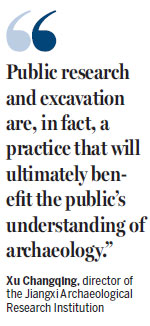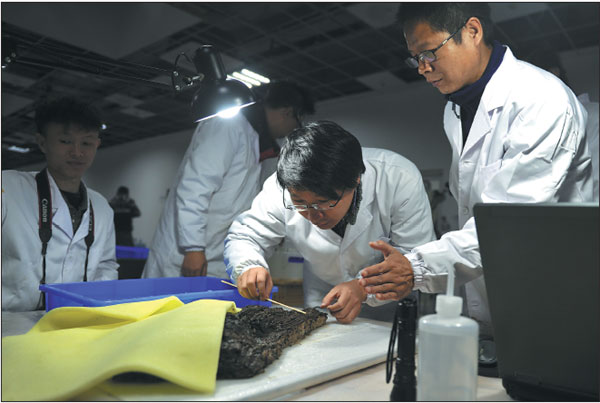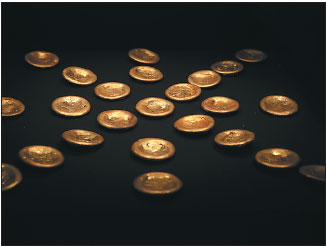Treasures fit for an emperor?
The newly-unearthed relics from the tomb of Liu He may offer fresh insights into both China's history and the man's character, Lei Xiaoxun reports.
Archaeologists working in Nanchang, capital of East China's Jiangxi province, announced on Oct 9 the successful completion of excavation work on the tomb of Liu He (92-59 BC), who was later given the title "Haihunhou" (the Marquis of Haihun).
Liu was the grandson of Emperor Wu, the greatest ruler of the Han Dynasty (206 BC-AD 220), one of the most prosperous periods in Chinese history.
Both Liu's dramatic life story and the rich treasures unearthed from his tomb continue to generate huge public interest.

More than 900 rare and amazingly delicate cultural relics, including the mysterious marquis' personal white jade seal, were put on permanent display at an exhibition at Jiangxi Provincial Museum in Nanchang on Oct 11.
The Western Han Dynasty (206 BC-AD 24) tomb is incredibly sophisticated in terms of structure, composition and layout, and is perhaps the best-preserved example of an ancient Chinese royal burial.
The excavation work has led to the discovery of more than 10,000 ancient royal relics, such as bronze wares, gold ingots and plates, gold discs inlaid with precious stones, jade carvings, which represent the highest craftsmanship of the period, bamboo slips, inscribed wooden tablets, lacquerware decorated with gold and silver, bronze and iron musical instruments which are numbered and positioned in the royal manner.
The exhibition in Nanchang is the third time that relics from Marquis Haihun's tomb have been put on public display. Jiangxi Provincial Museum put on a brief exhibition in November and December 2015 following the completion of the first phase of excavation, and Beijing Capital Museum's exhibition of the pieces drew thousands of daily visitors during its six-month duration since early March.
Li Ronghua, deputy curator of Jiangxi Provincial Museum, confirmed that the exhibition will remain permanently open to the public.
Li said the design of the exhibition fuses typical elements from Han Dynasty architecture.
The exhibition's color scheme is principally red and gold, derived from the color of the unearthed tomb relics, which are mostly lacquer, gold and bronze wares.
Liu He was deposed as emperor after only 27 days, dethroned by the royal clan because of his lack of talent and morals, according to historical records.
However, unearthed artifacts from the tomb could shed new light on Liu He and his life. A long mirror, for instance, with Confucius' life story and instructions written on the back, may prove that Liu He was, in fact, a devout student of the ancient Chinese philosopher.
Liu He's tomb is the largest and most important of its type yet excavated in terms of the ranking of its occupant and the sheer number and value of the artifacts found, both in terms of financial and research value.
About 400 pieces of gold have been unearthed from Liu He's tomb, which is somewhat strange for the tomb of a dethroned monarch. It also appears to contradict strict royal burial protocols of the time, which decreed that only a monarch should be buried in such magnificence.
High-resolution X-ray scans indicate that an unknown number of delicate agate beads, gilded bronze boxes and jade-decorated bronze plaques are still intact in the remaining lacquer containers inside the coffin.
Many archaeologists believe that the tomb has opened a doorway to a new understanding of ancient Chinese people and their culture.
The excavation work, which officially started five years ago, is also regarded as a monumental event in so-called public archaeology in China - an idea that was recently introduced to Chinese archeologists.
According to previous media reports, the Jiangxi provincial government has decided to construct a large museum in Nanchang bearing Marquis Haihun's name, with an estimated area of 7 square kilometers.
The museum will be built according to state-of-the-art design practices, according to experts at the State Administration of Cultural Heritage.
Xu Changqing, director of the Jiangxi Archaeological Research Institution, said:"Public research and excavation are, in fact, a practice that will ultimately benefit the public's understanding of archaeology and the role it plays in cultural education."
Contact the writer at leixiaoxun@chinadaily.com.cn
|
Archaeologists study inscribed bamboo slips unearthed at the tomb of Liu He. Excavation work on the tomb was completed on Oct 9.Guo Jing / For China Daily |
|
About 400 pieces of gold have been unearthed from Liu He’s tomb.Jiang Dong / China Daily |
|
An exhibition of relics from Liu He’s tomb at Beijing Capital Museum draws thousands of visitors every day.Jiang Dong / China Daily |
(China Daily 10/28/2016 page11)

















